
This article is an excerpt from NauticEd’s online Skipper Large Keelboats Course, a comprehensive online sailing course for beginner to intermediate sailors to learn how to sail large sailboats 26 ft (8m) and above. The Skipper Large Keelboats course is part of the Skipper Course Bundle of online courses, also teaching you how to master maneuvering under power and docking!
You can learn to sail and improve your sailing with NauticEd, the international leader in sailing education.
Raising the Alarm in Emergencies
VHF
Procedure for VHF Channel 16 MAYDAY:
- Switch to Channel 16. All Distress signals via VHF are initiated on Channel 16. This is a worldwide protocol.
- Distress signal “MAYDAY”, spoken three times.
- The words “THIS IS”, spoken once.
- Name of vessel in distress (spoken three times) and call sign or boat registration number, spoken once.
- Repeat “MAYDAY” and the name of the vessel, spoken once with the call sign.
- Give the position of the vessel by latitude or longitude or by bearing (true or magnetic, state which) and distance to a well-known landmark such as a navigational aid or small island, or in any terms which will assist a responding station in locating the vessel in distress. Include any information on vessel movements such as course, speed, and destination.
- Nature of distress (sinking, fire, etc.).
- Kind of assistance desired.
- Number of persons onboard.
- Any other information that might facilitate rescue, such as length or tonnage of the vessel, number of persons needing medical attention, color hull, cabin, masks, etc.
- The word “OVER”
Stay by the radio if possible. You’ll probably need to repeat information and answer further questions, particularly concerning your location.
For example:
MAYDAY-MAYDAY-MAYDAY
THIS IS BLUE DUCK-BLUE DUCK-BLUE DUCK
Call sign WA1234 MMSI number 233006734
MAYDAY BLUE DUCK
Call sign WA1234 MMSI number 233006734
OUR POSITION IS CAPE HENRY LIGHT BEARS 185 DEGREES MAGNETIC-DISTANCE 2 MILES
OUR CONDITION, WE HAVE STRUCK A SUBMERGED OBJECT
WE REQUIRE PUMPS, MEDICAL ASSISTANCE, AND TOW
THERE ARE THREE ADULTS AND TWO CHILDREN ONBOARD
ONE PERSON HAS A COMPOUND FRACTURE OF ARM
ESTIMATE CAN REMAIN AFLOAT FOR TWO HOURS
BLUE DUCK IS A THIRTY-TWO FOOT CABIN CRUISER-WHITE HULL-BLUE DECK HOUSE
OVER
Repeat at intervals until an answer is received.
Keep in mind that you may know how to make a MAYDAY call but your crew may not.
Therefore Download this Mayday Call document – laminate and put it on your boat near the VHF radio.
Or download this smaller version, laminate it, and zip tie it to your VHF mic cord.
Calls Other than Distress on VHF
Urgency: “PAN, PAN, PAN” (PAHN PAHN PAHN). This is the International Urgency Signal and is used when a vessel or person is in some jeopardy of a degree less than would be indicated by Mayday.
Safety: “SECURITY, SECURITY, SECURITY” (SAY-CURE-IT-TAY). This is the International Safety Signal and is a message about some aspect of navigational safety or a weather warning. You will most often hear this from the Coast Guard. Listen and take appropriate actions if necessary. For example, perhaps a navigational aid has drifted off station or a tornado watch has been issued.
The United States Coast Guard’s website and recommendations on VHF distress signals is here:
Digital Select Calling (DSC)
Digital Select Calling (DSC) is a means by which a digital distress signal is broadcast via VHF Channel 70. Local Coast Guard stations monitor this in real-time. DSC will report your GPS position, your vessel name and type, and the nature of your distress via a selectable text menu. However, there is a caveat; when you buy your DSC you must register it and hook it up to your GPS unit. Instructions for this will be with the unit manual.
It is important to send a DSC signal first when in an emergency situation because pertinent information such as your vessel type, name, and position is broadcast digitally to all vessels in your VHF range vicinity, which gains more accurate and faster response times. After the DSC alert, you should send a voice alert. The Coast Guard monitors DSC 24/7. When they receive a DSC call they are instantly given extremely accurate and helpful information to speed and enhance the success of the rescue.
The DSC will likely have a selection of prescribed alerts from which you can select. If time is short, holding the red distress button will send a standard distress signal with your location. To initiate the DSC, open the distress cover and either (1) hold the distress red button for five seconds for the standard message or (2) press the red distress button and then select the best-suited message from the menu.
Watch this video interview with the Coast Guard.
USCG Video Interview
Now watch how to send a DCS message including a DSC distress signal.
Sending a DCS Signal
The United States Coast Guard’s website and recommendations on DSC distress signals is here:
EPIRB (Emergency Position Indicating Radio Beacon)
An EPIRB is an emergency device that will report distress and your position to monitoring stations via satellite. It is automatically set off when immersed in water and is automatically released from its mount if the boat is sinking. While not required in most countries, it is a must for every vessel.
This video is from the Survival at Sea team and discusses EPRIB as well as PLBs (Personal Locator Beacons).
EPIRB
Mobile (Cell) Phones
Everyone carries a cell phone these days and people are more connected. Don’t discount using your mobile phone for raising the alarm. It would even be prudent to input the phone number of your local Coast Guard station into your address book.
However, the downside to mobile phone alarms is that you are talking to only one person at a time. There is also a long list of reasons why a cell phone is not your best choice: the signal may drop, or be garbled, the range is limited to the closest tower, phones are typically not waterproof, you’re relying on the battery being enough throughout the operation, you cannot transmit your position as well as a DSC, and the brave men and women that come to save you won’t be holding their phone to their ears—they will be on VHF.
Learn to use your VHF and DSC.
Flares
This is a video created by Marine and Safety Tasmania. You should check your local country’s rules for the requirements of carrying flares that are mentioned in this video.
Flares Video
A bit of important basic information first:
Read the instructions on all flares and always store a set of protective flare gloves in the flare container to protect your hands when setting off flares. Keep all flares in a watertight container. Flares have a shelf life; remember to check their date stamps. Don’t look directly at the flare when it is going off. Hold at arm’s length. When possible, only knowledgeable and experienced persons should use the flares.
- NEVER activate marine flares in a non-emergency situation on or near regulated water. It is illegal.
- NEVER dispose of flares in household trash.
- CONTACT your local fire department or Coast Guard about disposal.
Types of Flares
Flares come in many different types for different alerting requirements:
- Red Handheld Flares
A short-range distress signal is used to pinpoint position during the day or night. It burns with a light intensity of 15,000 candela for a duration of 60 seconds. Hold over the side of the boat and downwind to stop red-hot sparks falling onto your vessel. Visibility is about 3 miles.
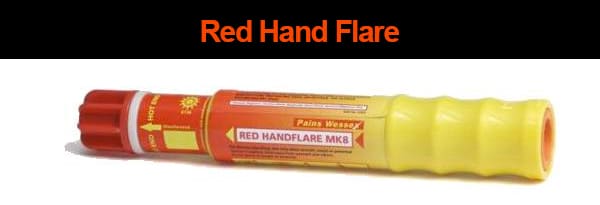
- Orange Smoke Flares
This handheld signal produces a dense orange smoke for daylight distress signaling. Ideal to indicate wind direction to rescue helicopters in land or sea rescues. Burning time is 60 seconds.

- White Collision Flares
White handheld flares are for day and night use as a short-range collision warning signal and also for illuminating small areas.

- Float Smoke Flares
This is a small and compact distress signal for daylight use only. There is a smoke signal that floats on the water for position marking during rescue operations. Indicates wind direction. Safe for use on oil or fuel-covered water.
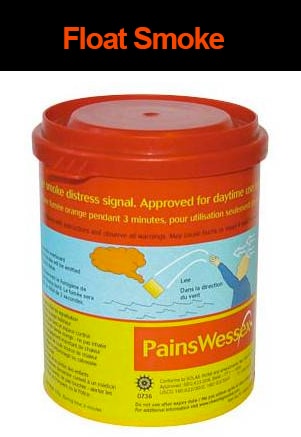
- Red Rocket Flares
Longer range than a handheld, it ejects a red flare on a parachute at 1,000 feet (300 meters), burning for 40 seconds at 30,000 candelas. This gives the flare around 30 miles of visibility, allowing vessels over the horizon and out of the line of sight to potentially see your distress signal. Point the flare downwind. Fire a second flare a minute or so after your first. This gives the observer a chance to confirm the sighting and gain a bearing on your location.

- LED Flare
- A new innovation in the market is an extremely bright Red LED Stick. While it does not meet the legal requirements for coded and commercial vessels yet, that is only because it is under test and review. Major advantages are that it can “burn” for five hours and the unit can quickly flash or send out a coded SOS signal.

Flare Kits
Offshore Flare Kit
These will usually contain 4 collisions, 4 red handhelds, 4 rockets, and 2 smoke flares.
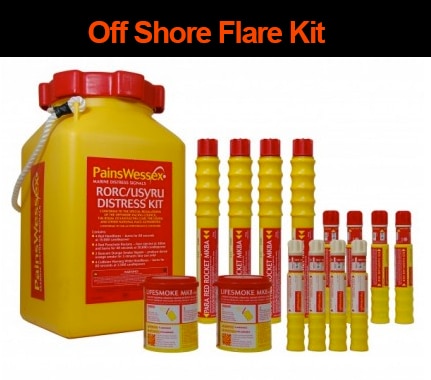
Coastal Flare Kits
These will usually contain 2 red handhelds, 2 rockets, and 2 smoke flares
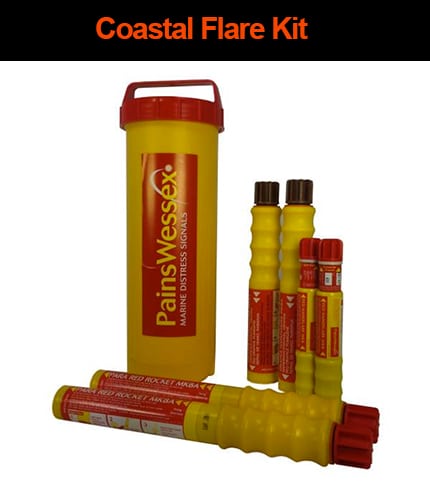
Inshore Flare Kits
These will usually contain 2 red handheld and 2 smoke flares
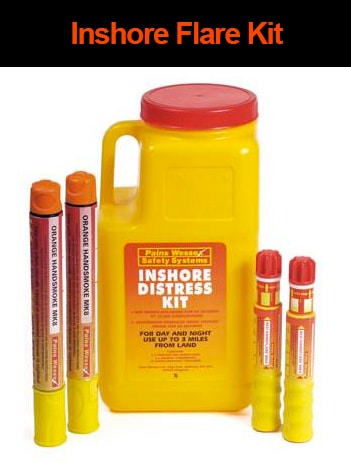
SOS
What’s in a WordThe origin of SOS is interesting. While people commonly think of it as Save Our Souls or Save Our Ship, in actual fact, SOS stands for nothing. It was created as such because the Morse code signal is distinct and difficult to confuse with other signals. |
In Morse code, 3 shorts is “S” and 3 longs is “O.”
SOS, then, is 3 short, 3 long, 3 short. You are not expected to know Morse code, so the easiest way to not get mixed up between shorts and longs for S and O is that the message is logically the shortest message for emergency purposes (that is, 3 longs—3 shorts—3 longs would be a longer message than the correct message of 3 shorts—3 longs—3 shorts).
A flashlight or sound device can be used to make this signal.
Other Distress Signals
The United States Coast Guard, in their navigation rules (rule 37) shows this diagram for other distress signals.

Distress Signals
The Code V Flag, which is a large red X, is not a distress signal but it means “I require assistance.”

Other flags’ meanings are listed well on Wikipedia
You can learn more in the Skipper Course....
Knowledge and theory for longer distances and overnight sailing in diverse conditions. The Skipper Course is a comprehensive online sailing course for beginner to intermediate sailors wanting to learn how to sail larger sailboats 26ft to 56ft. Or upgrade to the Skipper Course Bundle of online courses to also master maneuvering under power and docking!
